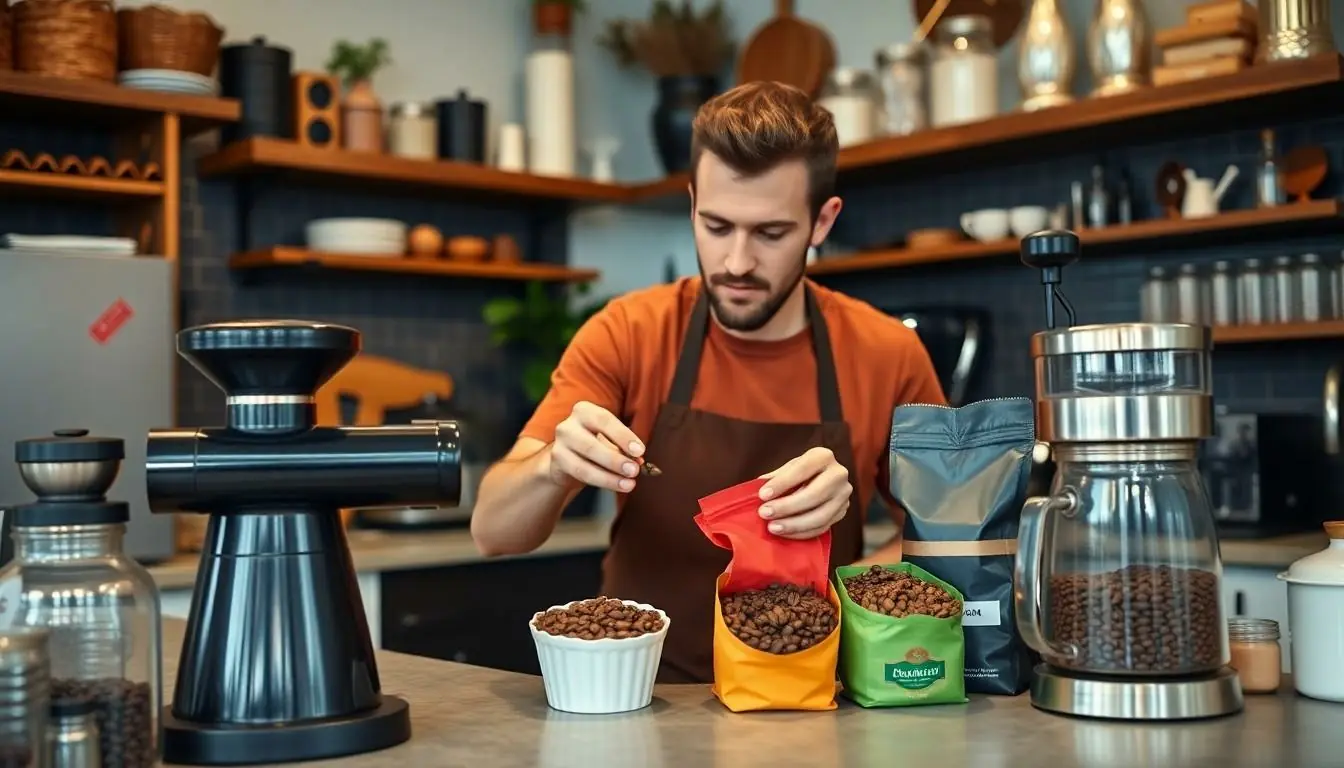In a world where coffee shops reign supreme and baristas flaunt their frothing skills, making a latte at home might seem like a daunting task. But fear not! With a few simple tricks up your sleeve, you can whip up a café-quality latte without ever changing out of your pajamas. Yes, it’s time to trade that overpriced cup for a cozy morning ritual that’ll have your taste buds dancing.
Imagine the aroma of freshly brewed espresso mingling with velvety steamed milk, all crafted in the comfort of your kitchen. Not only will you save a few bucks, but you’ll also impress friends and family with your newfound barista prowess. So grab your favorite mug and let’s dive into the art of latte-making—because who doesn’t want to be the master of their own caffeine kingdom?
Table of Contents
ToggleEssential Equipment for Making a Latte at Home
Latte-making at home requires specific equipment to achieve that café-quality experience. The right tools streamline the process and enhance the final product.
Espresso Machine
An espresso machine serves as the heart of the latte-making process. Many models offer various features, including manual, semi-automatic, and fully automatic options. A machine with at least 9 bars of pressure ensures optimal extraction of flavors from the coffee grounds. Consider machines with built-in grinders for convenience, and always choose models that match personal skill levels. Investing in a quality espresso machine elevates the overall latte experience.
Grinder
A grinder significantly impacts the flavor and quality of the espresso shot. Nailing the grind size is crucial; it should be fine to achieve the best extraction. Burr grinders excel over blade grinders due to their consistency and uniformity. Selecting the right grinder enhances the aroma and taste of freshly ground coffee. Regular maintenance, such as cleaning the grinder, ensures optimal performance and longevity.
Milk Frother
A milk frother transforms ordinary milk into creamy, velvety microfoam. Several options exist, including handheld frothers, steam wands, and automated frothing pitchers. Using whole or 2% milk produces the best texture, while non-dairy alternatives can also work, depending on personal preferences. Mastering the frothing technique creates that signature latte art, enhancing the visual appeal. Investing in a quality milk frother opens up exciting possibilities for experimenting with different milk-based drinks.
Choosing the Right Coffee Beans
Selecting the right coffee beans significantly impacts the flavor of a homemade latte. He or she can choose between single-origin beans or blends, depending on personal preference.
Single-Origin vs. Blends
Single-origin beans come from one specific region or farm, providing unique flavors and aromas inherent to that area. Many coffee enthusiasts appreciate the distinct taste profiles associated with different regions. Blends, on the other hand, combine beans from various sources to create a balanced flavor, offering complexity and consistency. Baristas often recommend experimenting with both types to discover personal favorites.
Roast Levels
Roast levels play a critical role in defining the taste of coffee. Light roasts offer bright, fruity flavors that showcase the bean’s character, appealing to those who enjoy nuanced tastes. Medium roasts balance acidity and body, delivering a smoother experience. Dark roasts yield rich, bold flavors with a hint of bitterness, often favored by those who prefer a stronger coffee taste. Understanding roast levels helps in choosing the right beans for an ideal latte.
Step-by-Step Guide to Make a Latte at Home
Making a latte at home involves a few straightforward steps that lead to a delicious beverage.
Brewing the Espresso
Start by grinding fresh coffee beans to a fine consistency. Espresso machines function best when the grind is uniform. Use 18 to 20 grams of coffee for a double shot, ensuring optimal flavor. With the machine heated and the portafilter locked in, pull the shot. A brewing time of 25 to 30 seconds produces the rich, concentrated espresso needed for a latte. The crema forming on top signifies a well-pulled shot, adding a beautiful touch to the final drink.
Steaming and Frothing the Milk
Fill a stainless steel pitcher with cold milk, aiming for about one-third of the pitcher’s capacity. Submerge the steam wand just beneath the surface to create microfoam. Frothing should begin with a whispering sound, indicating the milk’s aerating. Achieve a temperature of around 150°F for optimum sweetness and texture. Continue steaming until you see a velvety texture, perfect for pouring. Precision in this step directly affects the latte’s creaminess.
Combining Espresso and Milk
Pour the brewed espresso into a pre-warmed cup for the best temperature retention. Gradually add the frothed milk, starting right in the center for even distribution. Angle the pitcher slightly to enable smooth pouring. Use a gentle motion to create latte art, if desired, by manipulating foam. The balance of espresso and milk should create a harmonious flavor experience, enhancing enjoyment. This combination results in a beautifully crafted latte ready to savor.
Tips for Enhancing Your Homemade Latte
Enhancing a homemade latte involves both flavor and presentation techniques. Small adjustments can elevate the overall experience.
Flavor Additions
Flavor additions can transform a simple latte into a rich indulgence. Vanilla syrup, chocolate sauce, or caramel drizzle works well to add sweetness. Experimenting with flavored syrups or sprinkle cinnamon atop the foam enhances taste. Tasting flavored milk options, like almond or oat milk, introduces new dimensions too. For a unique twist, consider adding a dash of nutmeg or a hint of peppermint during the holiday season. Infusing your favorite spices or extracts offers endless possibilities for customized lattes.
Presentation Techniques
Presentation techniques elevate the visual appeal of a latte. Latte art, made by skillfully pouring frothed milk, creates stunning designs. Using a heart or rosette shape adds charm. Investing time in frothing milk to achieve creamy microfoam significantly impacts the final look. Utilizing decorative mugs or glasses showcases the beverage beautifully. Adding a sprinkle of cocoa powder or cinnamon on top not only improves aesthetics but also enhances flavor. An impressive presentation engages the senses from first glance.
Conclusion
Making a latte at home is not just a cost-effective way to enjoy a café favorite but also a rewarding experience. With the right equipment and a bit of practice anyone can master the art of brewing a delicious latte. The journey from selecting quality beans to perfecting the frothing technique opens up a world of flavor and creativity.
As one experiments with various ingredients and presentation styles the possibilities become endless. Whether it’s adding a splash of vanilla or creating stunning latte art each cup can be a unique expression of personal taste. Embracing this process not only enhances morning routines but also brings a touch of café culture into the home. So grab those tools and start crafting the perfect latte today.





